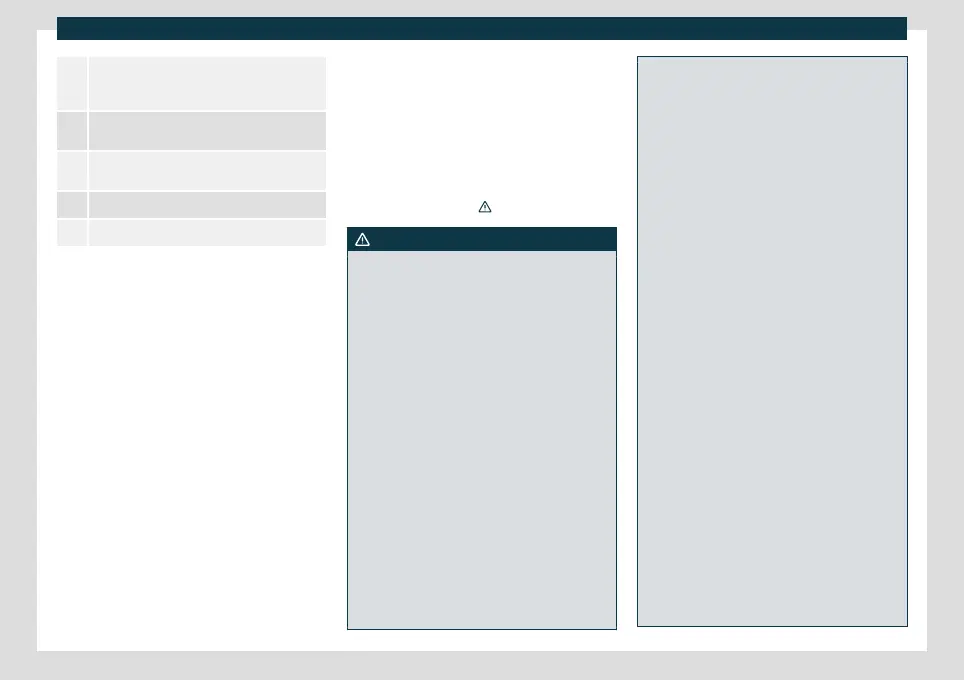Practical tips
Battery acid is extremely corrosive. Wear pro-
tective gloves and eye protection. Rinse any
splashes of electrolyte with plenty of water.
Fires, sparks, open flames and smoking are pro-
hibited.
The battery should only be charged in a well-
ventilated zone. Risk of explosion!
Keep children away from acid and batteries!
Always follow the instruction manual.
Disconnecting the battery
The batt
ery should only be disconnect
ed in
exceptional cases. When the battery is dis-
connected, some of the vehicle's functions
are lost. These functions will require reset-
ting after the battery is reconnected.
When disconnecting the battery from the
vehicle on-board network, disconnect first
the negative cable and then the positive ca-
ble.
Deactivate the anti-theft alarm* before you
disconnect the battery Otherwise the alarm
will be triggered.
If the vehicle is not used for long periods
The vehicle has a system for monitoring the
current consumption when the engine is left
unused for long periods of time
›››
page 333 .
Some functions, such as the interior lights,
or the remote door opening, may be tempo-
rarily disabled to prevent the battery from
running flat. These functions will come back
on as soon as the ignition is switched on and
the engine started.
Winter conditions
During the winter, the starting power may be
reduced, and if necessary, the battery
should be charged
›››
WARNING
Always be aware of the danger of injury and
chemical burns as well as the risk of acci-
dent or fire when working on the battery
and the electrical system:
●
Wear eye protection. Protect your eyes,
skin and clothing from acid and particles
containing lead.
●
Battery acid is extremely corrosive. Wear
protective gloves and eye protection. Do
not tilt the batteries. This could spill acid
through the vents.
●
Neutralise any electrolyte splashes on the
skin, eyes or clothing with a soapy solution,
and rinse off with plenty of water. If acid is
swallowed by mistake, consult a doctor im-
mediately.
●
Fires, sparks, open flames and smoking
are prohibited. When handling cables and
electrical equipment, avoid causing sparks
and electrostatic charge. Never short the
battery terminals. High-energy sparks can
cause injury.
●
A highly explo
sive mixture of gases is re-
leased when the battery is under charge.
The batteries should be charged in a well-
ventilated room only.
●
Keep children away from acid and batter-
ies.
●
Before working on the electrical system,
you must switch off the engine, the ignition
and all electrical devices. The negative ca-
ble on the battery must be disconnected.
When a light bulb is changed, you need on-
ly switch off the light.
●
Deactivate the anti-theft alarm by un-
locking the vehicle before you disconnect
the battery! The alarm will otherwise be
triggered.
●
When disconnecting the battery from the
vehicle on-board network, disconnect first
the negative cable and then the positive
cable.
●
Switch off all electrical devices before re-
connecting the battery. Reconnect first the
positive cable and then the negative cable.
Never reverse the polarity of the connec-
tions. This could cause an electrical fire.
●
Never charge a frozen battery, or one
which has thawed. This could result in ex-
plosions and chemical burns. Always re-
place a battery which has frozen. A flat bat-
tery can also freeze at temperatures close
to 0°C (+32°F).
●
Ensure that the vent hose is always con-
nected to the battery.
330

